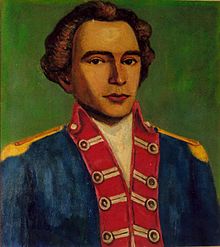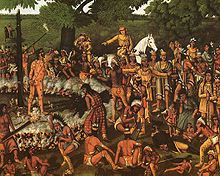- William Crawford (soldier)
-
For other people of the same name, see William Crawford (disambiguation).
William Crawford (1732 – 11 June 1782) was an American soldier and surveyor who worked as a western land agent for George Washington. Crawford fought in the French and Indian War and the American Revolutionary War. He was tortured and burnt at the stake by American Indians in retaliation for the Gnadenhutten massacre, a notorious incident near the end of the American Revolution.
Contents
Early career
In 1732, Crawford was born in Orange County, Virginia, at a location which is now in Berkeley County, West Virginia.[1] He was a son of William Crawford and his wife Honora Grimes,[2] who were Scots-Irish farmers. After his father's death in 1736, his mother married Richard Stephenson. Crawford had a younger brother, Valentine Crawford, plus five half-brothers and one half-sister from his mother's second marriage.[3]
In 1749, Col. William Crawford became acquainted with George Washington, then a young surveyor the same age as Crawford. He accompanied Washington on surveying trips and learned the trade. In 1755, Crawford served in the Braddock expedition with the rank of ensign. Like Washington, he survived the disastrous Battle of the Monongahela. During the French and Indian War, he served in Washington's Virginia Regiment, guarding the Virginia frontier against Native American raiding parties. In 1758, Crawford was a member of General John Forbes's army which captured Fort Duquesne, where Pittsburgh, Pennsylvania now stands. He continued to serve in the military, taking part in Pontiac's War in 1763.
In 1765 Crawford built a cabin on the Braddock Road along the Youghiogheny River in what is now Connellsville, Fayette County, Pennsylvania. His wife and three children joined him there the following year. Crawford supported himself as a farmer and fur trader. When the 1768 Treaty of Fort Stanwix with the Iroquois opened up additional land for settlement, Crawford worked again as a surveyor, locating lands for settlers and speculators. Governor Robert Dinwiddie had promised bounty land to the men of the Washington's Virginia Regiment for their service in the French and Indian War. In 1770 Crawford and Washington travelled down the Ohio River to choose the land to be given to the regiment's veterans. The area selected was near what is now Point Pleasant, West Virginia. Crawford also made a western scouting trip in 1773 with Lord Dunmore, Governor of Virginia. Washington could not accompany them because of the sudden death of his stepdaughter.[4]
At the outbreak of Dunmore's War in 1774, Crawford received a major's commission from Lord Dunmore. He built Fort Fincastle at present Wheeling, West Virginia.[5] He also led an expedition which destroyed two Mingo villages (near present Steubenville, Ohio) in retaliation for Chief Logan's raids into Virginia.[6] During the expedition, Crawford's men rescued two captives held by American Indians, killing six and capturing 14 Indians.[2]
Crawford's service to Virginia in Dumore's War was controversial in Pennsylvania, since the colonies were engaged in a bitter dispute over their borders near Fort Pitt. Crawford had been a justice of the peace in Pennsylvania since 1771, first for Bedford County, then for Westmoreland County when it was established in 1773. Arthur St. Clair, another Pennsylvania official, called for Crawford to be removed from his office, which was done in January 1775. Beginning in 1776, Crawford served as a surveyor and justice for Virginia's short-lived Yohogania County.[7]
American Revolution
When the American Revolutionary War began, Crawford recruited a regiment for the Virginia Line of the Continental Army. On 11 October 1776, the Continental Congress appointed him colonel of the 7th Virginia Regiment. Crawford led his regiment in the Battle of Long Island and the retreat across New Jersey. He crossed the Delaware with Washington and fought at the battles of Trenton and Princeton. During the Philadelphia campaign, he commanded a scouting detachment for Washington's army.[8]
After the war on the western frontier intensified in 1777, Crawford was transferred to the Western Department of the Continental Army. He served at Fort Pitt under Generals Edward Hand and Lachlan McIntosh. Crawford was present at the Treaty of Fort Pitt in 1778, and helped to build Fort Laurens and Fort McIntosh that year. Resources were scarce on the frontier, however, and Fort Laurens was abandoned in 1779. In 1780, Crawford visited Congress to appeal for more funds for the western frontier. In 1781, he retired from military service.
 The Ohio Historical Society's marker at the Colonel Crawford Burn Site Monument in Wyandot County, Ohio.
The Ohio Historical Society's marker at the Colonel Crawford Burn Site Monument in Wyandot County, Ohio.
Crawford expedition
In 1782, General William Irvine persuaded Crawford to come out of retirement and lead an expedition against enemy Indian villages along the Sandusky River. Before leaving, on 16 May he made out his will and testament.[9] His son John Crawford, his son-in-law William Harrison, and his nephew and namesake William Crawford also joined the expedition.
After his election as commander of the expedition, Crawford led about 500 volunteers deep into American Indian territory with the hope of surprising them. However, the Indians and their British allies at Detroit had learned about the expedition in advance, and brought about 440 men to the Sandusky to oppose the Americans. After a day of indecisive fighting, the Americans found themselves surrounded. During a confused retreat, Crawford and dozens of his men were captured. The Indians executed many of them in retaliation for the Gnadenhütten massacre earlier in the year, in which about 100 peaceful Christian Indian men, women, and children had been murdered by Pennsylvania militiamen. Crawford's execution was brutal; he was tortured for at least two hours before he was burned at the stake. His nephew and son-in-law were also captured and executed. The war ended shortly thereafter, but Crawford's horrific execution was widely publicized in the United States, worsening the already strained relationship between Native Americans and European Americans.
Legacy
In 1982, the site of Colonel Crawford's execution was added to the National Register of Historic Places. In 1994, the Wyandot County Patriotic Citizens erected an 8.5 ft (2.6 m) Berea sandstone monument at the site. The Ohio Historical Society also has an historical marker nearby.
Crawford County, Ohio, Crawford County, Pennsylvania, and Crawford County, Indiana are named for William Crawford. So too is Colonel Crawford High School in North Robinson, Ohio.
There is a replica of Crawford's cabin in Connellsville, Pennsylvania.
Notes
- ^ At one point, the place of Crawford's birth was in Frederick County, Virginia. Butterfield, Expedition against Sandusky, 81.
- ^ a b O'Donnell, "William Crawford", 710.
- ^ Butterfield, Expedition against Sandusky, 81.
- ^ Butterfield, Expedition against Sandusky, 97.
- ^ Anderson, Colonel William Crawford, 7–8.
- ^ Butterfield (p. 99) and O'Donnell (p. 710) write that Crawford and his men did not participate in the Battle of Point Pleasant, while Miller (p. 311) writes that Crawford led 500 men into the battle.
- ^ Butterfield, Expedition against Sandusky, 100–102.
- ^ Butterfield, Expedition against Sandusky, 103–04.
- ^ Anderson, Colonel William Crawford, 17.
References
- Anderson, James H. Colonel William Crawford. Columbus: Ohio Archæological and Historical Publications, 1898. Originally published in Ohio Archæological and Historical Quarterly 6:1–34. Address delivered at the site of the Crawford monument on 6 May 1896. Available online from the Ohio Historical Society.
- Boatner, Mark Mayo, III. Encyclopedia of the American Revolution. New York: McKay, 1966; revised 1974. ISBN 0-8117-0578-1.
- Butterfield, Consul Willshire. An Historical Account of the Expedition against Sandusky under Col. William Crawford in 1782. Cincinnati: Clarke, 1873.
- Miller, Sarah E. "William Crawford". The Encyclopedia of the American Revolutionary War: A Political, Social, and Military History. 1:311–13. Gregory Fremont-Barnes and Richard Alan Ryerson, eds. Santa Barbara, California: ABC-CLIO, 2006. ISBN 1-85109-408-3.
- O'Donnell, James H., III. "William Crawford". American National Biography. 5:710–11. Ed. John A. Garraty and Mark C. Carnes. New York: Oxford University Press, 1999. ISBN 0-19-512784-6.
External links
- Historical marker in Pennsylvania, near the site where Crawford had a cabin along the Youghiogheny River.
- William Crawford (soldier) at Find a Grave
Categories:- 1732 births
- 1782 deaths
- People from Berkeley County, West Virginia
- American Revolutionary War executions
- American surveyors
- Continental Army officers from Virginia
- People of Virginia in the French and Indian War
- George Washington
- People executed by burning
- People in Dunmore's War
- People of Virginia of Pontiac's War
- Pennsylvania colonial people
- Virginia colonial people
- American people of Scotch-Irish descent
- American torture victims
- Executed American people
- British America army officers
Wikimedia Foundation. 2010.


